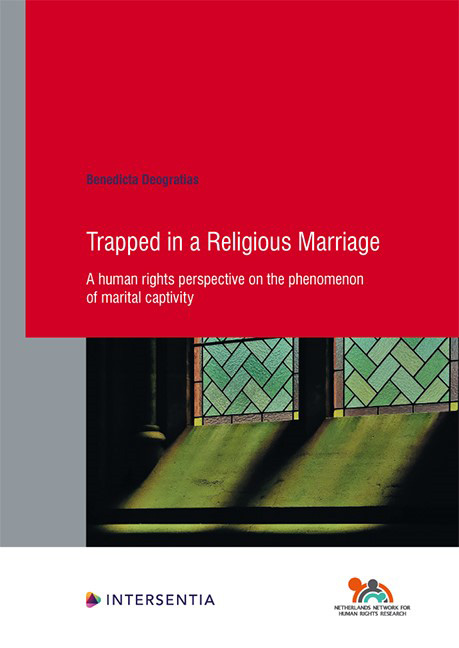Book contents
- Frontmatter
- Contents
- List of Frequently Used Abbreviations
- Chapter 1 Introduction to Marital Captivity
- Chapter 2 Religious Barriers to Divorce
- Chapter 3 Marital Captivity in the Netherlands
- Chapter 4 Marital Captivity and the Freedom of Religion
- Chapter 5 The Right to Divorce
- Chapter 6 The Trapped Spouse’s Rights
- Chapter 7 Violence Against Women
- Chapter 8 Conclusions
- Bibliography
- Curriculum Vitae
- Human Rights Research Series
Chapter 5 - The Right to Divorce
Published online by Cambridge University Press: 22 December 2020
- Frontmatter
- Contents
- List of Frequently Used Abbreviations
- Chapter 1 Introduction to Marital Captivity
- Chapter 2 Religious Barriers to Divorce
- Chapter 3 Marital Captivity in the Netherlands
- Chapter 4 Marital Captivity and the Freedom of Religion
- Chapter 5 The Right to Divorce
- Chapter 6 The Trapped Spouse’s Rights
- Chapter 7 Violence Against Women
- Chapter 8 Conclusions
- Bibliography
- Curriculum Vitae
- Human Rights Research Series
Summary
‘[I need the religious divorce], because I need our relationship to be over in every way.’
‘[S]ymbolically, [religious divorce] is very important given the place it took in our marriage, given that it was, you know, the sine qua non [ of our marriage], […] We must undo all the ties that bind us, including the religious. […] [If he had refused to give the get], I would have experienced that as an act of war.’
‘He wasn't bent on [religious principles], and neither was I. But I had a conscience problem, I told myself: “I can't do this to God,” you know! […] So we went to what they call a rabbinical court, where there are many rabbis. […] We had to have a get. It is a very important element for the woman to be freed from the husband and eventually remarry religiously.’
These accounts demonstrate another important and crucial factor that lies at the core of situations of marital captivity: the importance that religious adherents – the trapped spouses, the non-cooperative spouse and the religious community – attach to complying with religious rules, including those on divorce. Alongside religious motivations, a religious divorce may carry significant symbolic value and meaning for all involved. Its very pronunciation is perceived and experienced as bringing an end to the marriage, the marital life of the spouses and all and any ties between the spouses. It should not be forgotten that a situation of marital captivity can also have legal implications in other countries, which only adds to the perceived necessity of also dissolving the religious marriage in accordance with the religious rules.
Marriage and divorce are profound fundamental social structures that are prevalent in most societies. However, the roles attached thereto, their societal consequences and regulation differ from one country to the next. The institution of marriage is closely related to the foundation of family life. The very act of marriage establishes the basic family unit i.e. the spouses. It also encourages and legitimises the cohabitation and intimacy between the spouses, both socially and legally. In its turn, the family is the cornerstone of society.
- Type
- Chapter
- Information
- Trapped in a Religious MarriageA Human Rights Perspective on the Phenomenon of Marital Captivity, pp. 151 - 190Publisher: IntersentiaPrint publication year: 2020

